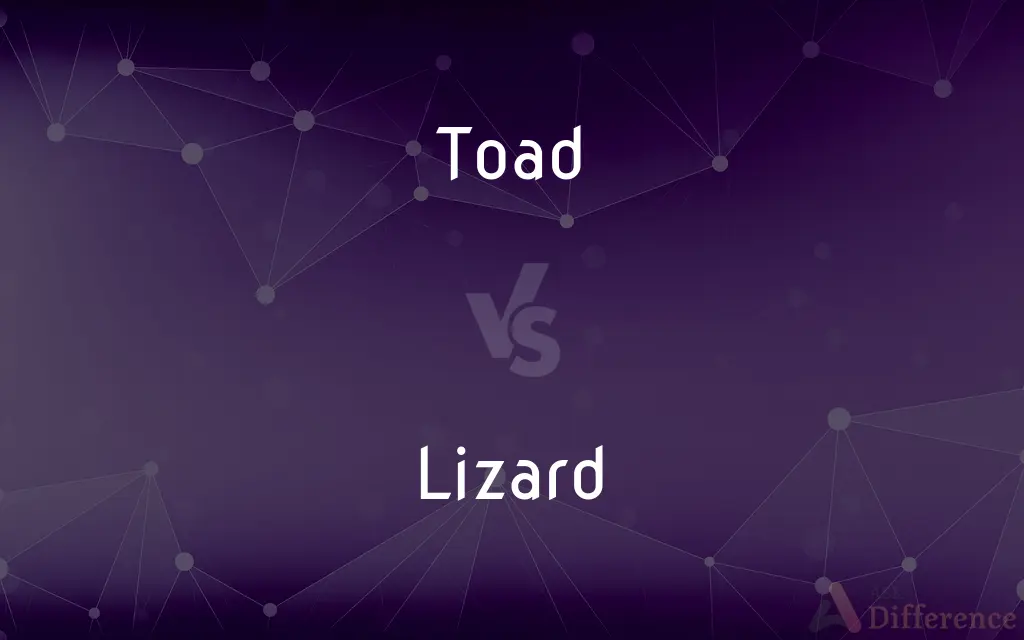Toad vs. Lizard — What's the Difference?
By Tayyaba Rehman & Maham Liaqat — Updated on March 22, 2024
Toads are amphibians with bumpy skin, while lizards are reptiles with scales.

Difference Between Toad and Lizard
Table of Contents
ADVERTISEMENT
Key Differences
Toads, belonging to the order Anura, are known for their stout bodies and short legs, which make them less adept at jumping compared to frogs. They have bumpy, often dry-looking skin and are more likely to be found in damp or moist terrestrial environments. In contrast, lizards, which are part of the order Squamata, possess elongated bodies, longer legs, and typically have scaly, smoother skin. They are adept climbers and can be found in a variety of habitats, from deserts to forests.
The reproductive strategies of toads involve laying eggs in water, where their offspring, tadpoles, undergo metamorphosis from an aquatic larval stage to a terrestrial adult form. Lizards, however, mostly lay eggs on land, and their young are miniature versions of adults at birth, bypassing any larval stage. This fundamental difference in life cycle reflects the distinct evolutionary paths of amphibians and reptiles.
Toads have parotoid glands behind their eyes that secrete a variety of toxins as a defense mechanism against predators. These toxins can be irritating or even harmful to other animals. Lizards, on the other hand, might employ different defense strategies, such as tail autotomy (detaching their tail to escape predators) or camouflaging with their environment to avoid detection.
While toads are primarily nocturnal, spending their days hidden to maintain moisture in their skin, lizards' activity patterns can vary widely among species. Some lizards are diurnal, active during the day, while others are nocturnal. This variance in behavior patterns highlights the adaptability of lizards to different environmental conditions.
In terms of diet, both toads and lizards are generally carnivorous, with toads primarily feeding on insects, worms, and small invertebrates. Lizards have a more varied diet, which, depending on the species, can range from insects and small mammals to fruits and vegetation, showcasing a wider dietary adaptability compared to toads.
ADVERTISEMENT
Comparison Chart
Classification
Amphibians
Reptiles
Skin Texture
Bumpy and often dry-looking
Scaly and smoother
Reproduction
Lay eggs in water, undergo metamorphosis
Mostly lay eggs on land, no larval stage
Defense Mechanisms
Secrete toxins from parotoid glands
Tail autotomy, camouflage
Activity Patterns
Primarily nocturnal
Can be diurnal or nocturnal
Diet
Mainly insects and small invertebrates
Varied, including insects, small mammals, and vegetation
Compare with Definitions
Toad
A member of the amphibian class characterized by dry, bumpy skin.
The common toad can be found in gardens and forests near water bodies.
Lizard
A reptile distinguished by its scaly skin and typically elongated body.
Lizards can be found basking in the sun on rocks and branches.
Toad
Typically found in moist terrestrial habitats.
After a rainstorm, toads often emerge to hunt for insects.
Lizard
Can have diverse diets, from carnivorous to omnivorous.
The diet of a lizard can include insects, fruits, and even small birds.
Toad
Utilize toxins for defense.
The parotoid glands behind a toad's eyes secrete a substance that deters many predators.
Lizard
Possesses external ear openings and movable eyelids.
Unlike snakes, lizards can blink and have visible ears.
Toad
Known for their short legs and poor jumping ability.
Unlike frogs, toads move mainly by walking rather than jumping.
Lizard
Exhibits a range of defense mechanisms, including tail shedding.
When threatened, some lizards can detach their tail to escape.
Toad
Reproduce by laying eggs in water.
In spring, toads return to ponds and streams to lay eggs.
Lizard
Reproduction varies, with most species laying eggs.
The female lizard lays her eggs in a warm, hidden location.
Toad
Toad is a common name for certain frogs, especially of the family Bufonidae, that are characterized by dry, leathery skin, short legs, and large bumps covering the parotoid glands.A distinction between frogs and toads is not made in scientific taxonomy, but is common in popular culture (folk taxonomy), in which toads are associated with drier, rougher skin and more terrestrial habitats.
Lizard
Lizards are a widespread group of squamate reptiles, with over 6,000 species, ranging across all continents except Antarctica, as well as most oceanic island chains. The group is paraphyletic as it excludes the snakes and Amphisbaenia; some lizards are more closely related to these two excluded groups than they are to other lizards.
Toad
Any of various anuran amphibians especially of the family Bufonidae, characteristically being more terrestrial and having drier, rougher skin and shorter legs than the smooth-skinned frogs.
Lizard
Any of numerous squamate reptiles often classified in the suborder Lacertilia, characteristically having a scaly elongated body with a tapering tail, four legs, movable eyelids, and external ear openings.
Toad
A horned lizard.
Lizard
Leather made from the skin of one of these reptiles.
Toad
A person regarded as repulsive.
Lizard
Any reptile of the order Squamata that is not a snake or an amphisbaenian, usually having four legs, external ear openings, movable eyelids and a long slender body and tail.
Toad
An amphibian, a kind of frog (order Anura) with shorter hindlegs and a drier, wartier skin, many in family Bufonidae.
Lizard
Lizard skin, the skin of these reptiles.
Toad
(pejorative) A contemptible or unpleasant person.
Lizard
(colloquial) An unctuous person.
Toad
(pejorative) An ugly person.
Lizard
(colloquial) A coward.
Toad
To expel (a user) permanently from a MUD or similar system, so that their account is deleted.
Lizard
(rock paper scissors) A hand forming a "D" shape with the tips of the thumb and index finger touching (a handshape resembling a lizard), that beats paper and Spock and loses to rock and scissors in rock-paper-scissors-lizard-Spock.
Toad
Any one of numerous species of batrachians belonging to the genus Bufo and allied genera, especially those of the family Bufonidæ. Toads are generally terrestrial in their habits except during the breeding season, when they seek the water. Most of the species burrow beneath the earth in the daytime and come forth to feed on insects at night. Most toads have a rough, warty skin in which are glands that secrete an acrid fluid.
Lizard
(in compounds) A person who idly spends time in a specified place, especially a promiscuous female.
Lounge lizard; lot lizard; beach lizard; truck stop lizard
Toad
Any of various tailless stout-bodied amphibians with long hind limbs for leaping; semiaquatic and terrestrial species
Lizard
Any one of the numerous species of reptiles belonging to the order Lacertilia; sometimes, also applied to reptiles of other orders, as the Hatteria.
Lizard
A piece of rope with thimble or block spliced into one or both of the ends.
Lizard
A piece of timber with a forked end, used in dragging a heavy stone, a log, or the like, from a field.
Lizard
Relatively long-bodied reptile with usually two pairs of legs and a tapering tail
Lizard
A man who idles about in the lounges of hotels and bars in search of women who would support him
Common Curiosities
Are toads harmful to humans?
Some toads secrete toxins that can be irritating or harmful, but they are generally not dangerous unless ingested or handled improperly.
Are toads active during the day?
Toads are primarily nocturnal, becoming active at night to hunt and mate.
How can you tell a toad from a lizard?
A toad has bumpy skin and a stout body, while a lizard has scaly skin and a more elongated body.
Can lizards live in both hot and cold climates?
Yes, lizards are adaptable and can be found in a wide range of climates, from deserts to temperate forests.
Do all toads have warts?
What appear to be "warts" on toads are actually glands; not all toads have these, and they vary in size and number.
How do toads survive in dry environments?
Toads can burrow into the ground to retain moisture and are more active during wetter conditions to prevent dehydration.
Do toads sing or croak?
Toads can produce various sounds, especially during mating season, commonly referred to as croaking.
What is the lifespan of a toad?
The lifespan of a toad can vary widely depending on the species, with some living over 10 years in the wild.
Are all toads poisonous?
Many toads have glands that produce toxins as a defense mechanism, but not all are dangerous to humans.
What do lizards eat?
Lizard diets vary widely among species, including insects, fruits, vegetables, and small animals.
Can lizards regenerate lost body parts?
Lizards can regenerate their tails, but other body parts, such as limbs, cannot be regenerated.
How do lizards defend themselves?
Lizards use various strategies, including tail autotomy, camouflage, and in some cases, venom.
Do lizards need water to lay their eggs?
Most lizards lay their eggs on land in moist, warm locations, but they do not require standing water like amphibians.
What habitats do lizards prefer?
Lizards can thrive in a variety of habitats, from deserts and forests to urban areas.
How do lizards regulate their body temperature?
As ectotherms, lizards regulate their body temperature through behavior, such as basking in the sun to warm up or seeking shade to cool down.
Share Your Discovery

Previous Comparison
Concrete vs. Concreate
Next Comparison
Pretentious vs. PhonyAuthor Spotlight
Written by
Tayyaba RehmanTayyaba Rehman is a distinguished writer, currently serving as a primary contributor to askdifference.com. As a researcher in semantics and etymology, Tayyaba's passion for the complexity of languages and their distinctions has found a perfect home on the platform. Tayyaba delves into the intricacies of language, distinguishing between commonly confused words and phrases, thereby providing clarity for readers worldwide.
Co-written by
Maham Liaqat














































